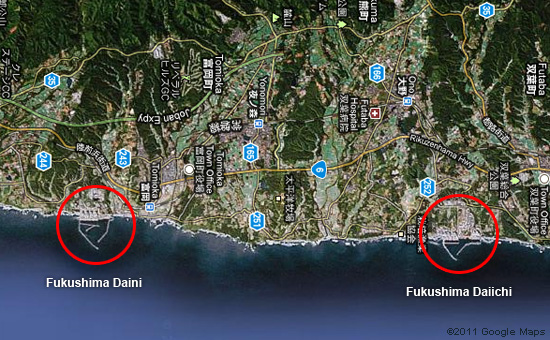Following the massive and devastating earthquake that hit Japan earlier today officials in the country has declared a state of emergency at the nuclear power plant in the Fukushima Prefecture. The state of emergency was issued at the plant after a cooling system failure. Japanese authorities say there is no radiation leak but that they are having trouble cooling the plant, Al Jazeera English reports.
We will continue the live-updates on this developing story here.
Update 23: According to some unverified sources, like this report (Japanese language), fuel rod have been exposed above cooling water level at the Fukushima nuclear plant. Around 50 cm of fuel rod bundle believed to be exposed. Also, we are getting news that the pressure release operation in Fukushima nuclear plant have been halted due to high radio activity.
Breaking news. Expert say fuel rod should not explode even if exposed out of water in Fukushima Nuclear Plant. #earthquake #japan
Update 22: The Guardian summaries the current situation in Japan:
Update 21: Here is a map showing the location of the two nuclear power stations that have been declared to be in a state of emergency by the Japanese government:
[caption id="attachment_2677" align="alignnone" width="550" caption="The Fukushima Daini and the Fukushima Daiichi nuclear power stations."] [/caption]
[/caption]
Update 20: Reuters report now that TEPCO are having difficulties to open a valve to release pressure at the Daiichi reactor.
ALERT-TEPCO having difficulties trying to open valve to release pressure at Daiichi reactor: Kyodo #japan #tsunami
Update 19: Bloomberg reports that Tokyo Electric Power Co. has started venting gas from one of the reactors.
Tokyo Electric Power Co. are now also apparently preparing to vent gas from a second reactor at the Fukushima Daini nuclear plant.
Update 18: Reuters report that Japan may only have "hours to prevent nuclear meltdown" following "a highly unusual "station blackout"".
Update 17: The Huffington Post asks if nuclear reactors in the USA could withstand an enormous quake similar to the one in Japan. "We do not believe the safety standards for U.S. nuclear reactors are enough to protect the public today," Edwin Lyman, senior scientist, global security programs, at the Union of Concerned Scientists, said. Reuters also have an article explaining what could happen when a reactor loses coolant. And here are some basic background on what's happening with the Fukushima nuclear plant from the Union of Concerned Scientists.
Update 16: The Campaign for Nuclear Disarmament in the UK have released a statement on the nuclear emergency situation in Japan saying that "today's incident underlines the constant danger that nuclear power presents":
Update 15: The situation in Fukushima seems to be escalating as the Guardian reports that the cooling systems has now failed at three other reactors at the nuclear power station:
AJE writes now: "With a state of emergency declared at another nuclear reactor, there are now five reactors under a state of emergency - two at Fukushima No.1 plant, and three at the nearby Fukushima No.2 plant."
Update 14: AJE reports that:
And that "a total of 45,000 people living within a 10km radius of the Fukushima nuclear power plant have now been told to evacuate their homes". This is really a steep increase from the 3000-6000 people who were gonna be evacuated initially.
Update 13: Tyler Durden over at zerohedge.com writes that the Japanese officials only have 24 hours to avoid a core meltdown scenario:
Update 12: Reuters reports that Tepco has lost the ability to control reactor pressure at Fukushima Daini nos. 1, 2, 4 reactors. But according to Tepco the pressure in the reactors is still stable.
Tepco says has lost ability to control reactor pressure at Fukushima Daini nos. 1, 2, 4 reactors
Update 11: AJE writes that: "Japan's nuclear safety agency says some radiation has now seeped outside the plant, prompting calls for further evacuation of the area, says the Associated Press news agency."
Update 10: If you are interested in more live-updates not just about the Fukushima nuclear power plant the Guardian and Al Jazeera English has both fast updates on the situation currently unfolding in Japan.
Update 9: According to AFP the radiation at the Fukushima nuclear power plant has reached levels 1,000 times of normal levels. And finally AJE can bring some sense to the story about US involvement. They report that: "Meanwhile, contrary to earlier reports, officials say that the US did not deliver nuclear coolant material, and that Japanese authorities handled the situation themselves."
Update 8: Japan officials are now expanding the evacuation area around the Fukushima nuclear plant from 3 km to 10 km, Reuters report.
Japan PM Kan orders expansion of evacuation area around Fukushima nuclear plant to 10 km from 3 km
Update 7: An independent nuclear safety analyst tells AJE that Japan officials must "manage a balancing act at the Fukushima nuclear power plant". Quote from the AJE live-blog:
Update 6: Pressure building in the plant was set to be released soon, a move that could result in a radiation leak, officials said. Some 3,000 people who live within a 3km radius of the plant have been evacuated, Kyodo news agency said. Cabinet chief Yukio Edanotol says that:
Update 5: The Fukushima nuclear power plant, where cooling systems were knocked out by the quake, is located 240km north of Tokyo. The Huffington Post reports that "the radiation level was rising in the turbine building and the pressure had risen to 1.5 times the designed capacity." And AJE reports that "officials at the Fukushima Daiichi nuclear power plant will release "slightly radioactive vapour" to ease pressure in one of the reactors after the cooling system failed following the huge earthquake".
Update 4: Now we are getting information that "a small radiation leak could occur" at the nuclear plant in Japan:
Japan's trade minister, Banri Kaieda, says a small radiation leak could occur at the Fukushima nuclear plant,Kyodo News Agency reported Sat.
Update 3: More updates on the situation at the Fukushima nuclear power plant from AJE: Nearly 6,000 residents living in a three-kilometre radius of the Fukushima No 1 nuclear power plant, where a cooling failure was reported, have now been ordered to evacuate.
Update 2: More updates on the nuclear emergency from Reuters who says that the United States has transported coolant to the Fukushima nuclear plant. The report quotes Hillary Clinton, the US Secretary of State, as saying:
Update 1: Al Jazeera English reports that: Authorities have told residents living near the Fukushima nuclear plant, hit by a fire earlier, to evacuate the area. Authorities said peole living in a two kilometre radius of the No.2 reactor of the Fukushima No.1 plant should leave.




Recommended Comments
Join the conversation
You can post now and register later. If you have an account, sign in now to post with your account.